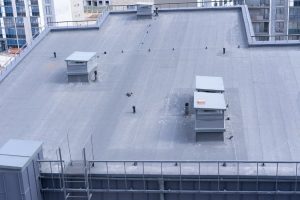


With so many choices for roofing available, built-up roofing may be on your list of options. But did you know that there are several methods for application that are classified as either hot or cold? At McDonald & Wetle, we educate our clients on the difference between hot and cold built-up roofing daily, as it can be a tricky decision to make when replacing or constructing your roof. Here’s a breakdown of hot and cold built-up roofing options and how you can decide which is best for your building.
What Is Built-Up Roofing?
Before you can determine if hot or cold built-up roofing is right for you, it’s important to understand what this technique involves. Also known as BUR, built-up roofing is arguably the most frequently used material for roofs with low slopes or that are considered flat. It is engineered to provide a continuous, secure seal across the roof’s entire surface and is composed of three elements: ply sheets, reinforcing fabric, and bitumen (asphalt) material.
This is where the hot and cold classifications come into play. The bitumen material may be hot, meaning it is heated to a liquid state during installation. Or, it may be cold, which typically entails spraying or using a squeegee to apply an adhesive that does not require heating. Which you should choose depends on several factors, which McDonald & Wetle will help you navigate. These include:
- Climate
- Location
- Your budget
- Environmental considerations
- Building construction
- Timeline for installing your new roof
- How the new roof may impact your building and its occupants
Hot BUR Installation
For years, installing hot BUR has proven to be a dependable and long-lasting choice for many building owners. Using on-site kettles, tankers, mop carts, and pumping equipment, the hot asphalt is pumped onto the roof’s surface and spread by the roofing professionals at McDonald & Wetle. When it’s all said and done, the hot BUR serves as a superior fire retardant and adds an attractive look to the building.
It’s important to keep in mind, however, that the equipment required may make installation tricky in crowded downtown or urban areas. That’s because everyone’s safety is top of mind, and the kettles and pumping equipment are usually kept at a distance from the building. In addition, the hot asphalt carries a strong odor during installation, so it’s best if the building is unoccupied during the process. Aside from those considerations, hot BUR can be installed on any flat rooftop year-round.
Cold BUR Installation
Requiring far less equipment than hot BUR installation, cold BUR is put in place by our roofers using sprayers, rollers, or other similar tools. This allows McDonald & Wetle to ensure an even, uniform coating of cold asphalt across the entire surface. It’s a popular choice for building owners, as cold BUR can handle a variety of environmental conditions.
Depending on the type of adhesive, cold BUR can be installed onto occupied buildings if no extra ventilation is required. But for the adhesive to be effective, outdoor temperatures at the time of installation should be roughly 45° to 50° Fahrenheit and rising.
Let Us Help You Make the Right Choice for Your Building
For your project to be successful, you must do more than carefully choose between the available built-up roofing options. You also need to ensure your installation is carried out by roofing experts like the ones at McDonald & Wetle, where 98 years of experience are utilized every day. For more information, contact us in the Seattle or Portland metro areas to discuss your roof and goals.
